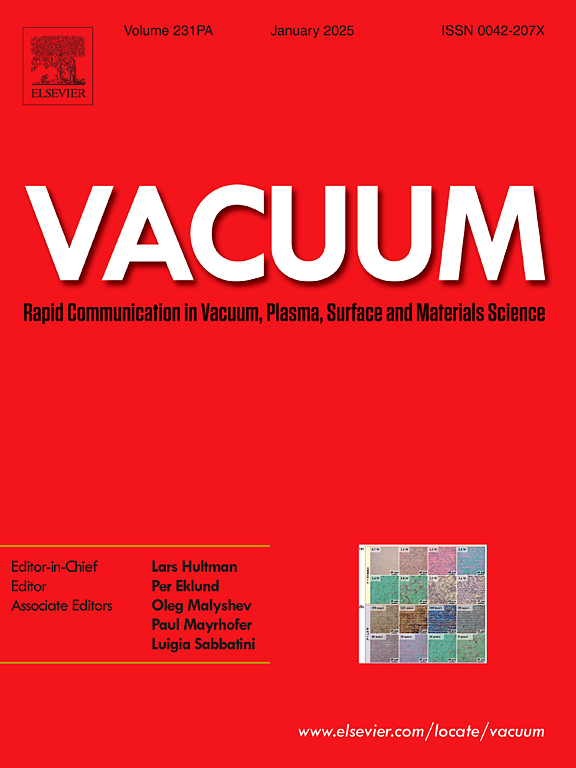Porous titanium nitride thin film for enhanced biosensing applications
IF 3.8
2区 材料科学
Q2 MATERIALS SCIENCE, MULTIDISCIPLINARY
引用次数: 0
Abstract
The development of electrochemical (EC) biosensors requires materials with superior stability, sensitivity and adaptability in complex biological settings. Traditional metal oxide-based EC sensors are often limited by matrix interferences, impacting sensitivity. Here, we present porous titanium nitride (p-TiN) thin film as a novel microelectrode (ME) material designed to overcome these limitations. Using a combination of Direct Current (DC) reactive sputtering and controlled isotropic wet etching at varied etchant ratios, we fabricated p-TiN thin films with tailored porosity, confirmed by comprehensive characterization techniques, including Scanning Electron Microscopy (SEM) coupled with Energy Dispersive Spectroscopy (EDS), Transmission Electron Microscopy (TEM) coupled with EDS Mapping, Raman Spectroscopy, Photoluminescence (PL), and Fourier Transform Infrared Spectroscopy (FTIR). Brunauer-Emmett-Teller (BET) analysis further validated the mesoporous structure, enhancing both wettability and hydrophilicity crucial for biosensing interfaces. Electrochemical impedance spectroscopy (EIS) and cyclic voltammetry verified the material's stability, purity and consistent capacitive behavior, with an effective capacitance of 10 μF across all scan rates. The p-TiN thin film electrode demonstrated low impedance, reinforcing its suitability and robustness for high-sensitivity applications. These findings establish porous titanium nitride thin film as a transformative material for next-generation biosensors, offering significant improvements in sensitivity, selectivity and durability for health and environmental applications.
多孔氮化钛薄膜增强生物传感应用
电化学(EC)生物传感器的发展要求材料在复杂的生物环境中具有优异的稳定性、灵敏度和适应性。传统的基于金属氧化物的电磁传感器常常受到基体干扰的限制,影响灵敏度。在这里,我们提出多孔氮化钛(p-TiN)薄膜作为一种新型微电极(ME)材料,旨在克服这些限制。利用直流(DC)反应溅射和控制各向同性湿法蚀刻在不同的蚀刻比下,我们制作了具有特定孔隙率的p-TiN薄膜,并通过综合表征技术,包括扫描电子显微镜(SEM)耦合能量色散光谱(EDS),透射电子显微镜(TEM)耦合EDS测绘,拉曼光谱,光致发光(PL)和傅里叶变换红外光谱(FTIR)来证实。brunauer - emmet - teller (BET)分析进一步验证了介孔结构,增强了生物传感界面的润湿性和亲水性。电化学阻抗谱(EIS)和循环伏安法验证了材料的稳定性、纯度和一致的电容行为,在所有扫描速率下有效电容均为10 μF。p-TiN薄膜电极具有低阻抗,增强了其在高灵敏度应用中的适用性和鲁棒性。这些发现确立了多孔氮化钛薄膜作为下一代生物传感器的变革性材料,为健康和环境应用提供了灵敏度,选择性和耐久性方面的显着改进。
本文章由计算机程序翻译,如有差异,请以英文原文为准。
求助全文
约1分钟内获得全文
求助全文
来源期刊

Vacuum
工程技术-材料科学:综合
CiteScore
6.80
自引率
17.50%
发文量
0
审稿时长
34 days
期刊介绍:
Vacuum is an international rapid publications journal with a focus on short communication. All papers are peer-reviewed, with the review process for short communication geared towards very fast turnaround times. The journal also published full research papers, thematic issues and selected papers from leading conferences.
A report in Vacuum should represent a major advance in an area that involves a controlled environment at pressures of one atmosphere or below.
The scope of the journal includes:
1. Vacuum; original developments in vacuum pumping and instrumentation, vacuum measurement, vacuum gas dynamics, gas-surface interactions, surface treatment for UHV applications and low outgassing, vacuum melting, sintering, and vacuum metrology. Technology and solutions for large-scale facilities (e.g., particle accelerators and fusion devices). New instrumentation ( e.g., detectors and electron microscopes).
2. Plasma science; advances in PVD, CVD, plasma-assisted CVD, ion sources, deposition processes and analysis.
3. Surface science; surface engineering, surface chemistry, surface analysis, crystal growth, ion-surface interactions and etching, nanometer-scale processing, surface modification.
4. Materials science; novel functional or structural materials. Metals, ceramics, and polymers. Experiments, simulations, and modelling for understanding structure-property relationships. Thin films and coatings. Nanostructures and ion implantation.
 求助内容:
求助内容: 应助结果提醒方式:
应助结果提醒方式:


